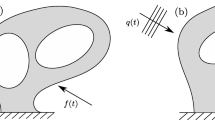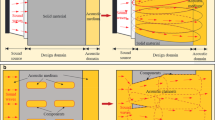Abstract
Resonance and wave-propagation problems are known to be highly sensitive towards parameter variations. This paper discusses topology optimization formulations for creating designs that perform robustly under spatial variations for acoustic cavity problems. For several structural problems, robust topology optimization methods have already proven their worth. However, it is shown that direct application of such methods is not suitable for the acoustic problem under consideration. A new double filter approach is suggested which makes robust optimization for spatial variations possible. Its effect and limitations are discussed. In addition, a known explicit penalization approach is considered for comparison. For near-uniform spatial variations it is shown that highly robust designs can be obtained using the double filter approach. It is finally demonstrated that taking non-uniform variations into account further improves the robustness of the designs.






















Similar content being viewed by others
Notes
The projection level for each realization may be taken to be constant throughout Ω d or one may introduce a projection-field η(x) which is allowed to vary throughout Ω d, as will be considered in Section 11.
The interested reader may find a derivation of the new sensitivities in ??.
References
Bendsøe MP, Sigmund O (2003) Topology optimization - theory, methods and application. Springer
Borrvall T, Petersson J (2001) Topology optimization using regularized intermediate density control. Computer methods in applied mechanical and engineering 190:4911–4928
Bourdin B (2001) Filters in topology optimization. Int J Numer Methods Eng 50:2143–2158
Bruns TE, Tortorelli DA (2001) Topology optimization of non-linear elastic structures and compliant mechanisms. Computational Methods for Applied Mechanical Engineering 190:3443–3459
Clausen A, Aage N, Sigmund O (2015) Topology optimization of coated structures and material interface problems. Computational Methods for Applied Mechanical Engineering 290:524–541
Desmet W (1998) A wave based prediction technique for coupled vibro-acoustic analysis. PhD thesis, Katholieke Universitet Leuven
Dühring MB, Jensen JS, Sigmund O (2008) Acoustic design by topology optimization. J Sound Vib 317:557–575
Du J, Olhoff N (2007) Minimization of sound radiation from vibrating bi-material structures using topology optimization. Structural and Multidiciplinary Optimization 33:305–321
Elesin Y, Lazarov B, Jensen J, Sigmund O (2012) Design of robust and efficient photonic switches using topology optimization. Photonics and Nanostructures Fundamentals and Applications 10 :153–165
Goo S, Kook J, Koo K, Hyun J, Wang S (2014) Acoustic topology optimization for interior acoustic problem using the hybrid finite element - wave based method. In: The Eighth China-Japan-Korea Joint Symposium on Optimization of Structural and Mechanical Systems
Guest JK, Prévost JH, Belytschko T (2004) Achieving minimum length scale in topology optimization using nodal design variables and projection functions. Int J Numer Methods Eng 61:238– 254
Hal BV, Desmet W, Pluymers B, Sas P, Vandepitte D (2003) A coupled finite element - wave based approach for the steady-state dynamics analysis of acoustic systems. J Comput Acoust:285–303
Jacobsen F, Juhl PM (2013) Fundamentals of General Linear Acoustics. Wiley
Kook J, Koo K, Hyun J, Jensen JS, Wang S (2012) Acoustical topologi optimization for zwicker’s loudness model - application to noise barriers. Computational Methods for Applied Mechanical Engineering 237:130–151
Lazarov BS, Schevenels M, Sigmund O (2012) Topology optimization considering material and geometric uncertainties using stochastic collocation methods. Structural Multidiciplinary Optimization 46:597–612
Lee JW, Kim YY (2009) Ridig body modeling issue in acoustic topology optimization. Computational Methods for Applied Mechanical Engineering 198:1017–1030
Lyon RH, DeJONG RG (1998) Statistical Energy Analysis. RH Lyon Corp
Schevenels M, Lazarov B, Sigmund O (2011) Robust topology optimization accounting for spatially varying manufacturing errors. Computational Methods for Applied Mechanical Engineering 200:3613–3627
Sigmund O (2009) Manufacturing tolerant topology optimization. Acta Mech Sinica 25:227–239
Svanberg K (1987) The method of moving asymptotes - a new method for structural optimization. Int J Numer Methods Eng 24:359–373
Wadbro E (2014) Analysis and design of acoustic transition sections for impedance matching and mode conversion. Structural and Multidiciplinary Optimization 50:395–408
Wadbro E, Berggren M (2006) Topology optimization of an acoustic horn. Computational Methods for Applied Mechanical Engineering 196:420–436
Wang F, Jensen JS, Sigmund O (2011a) Robust topology optimization of photonic crystal waveguides with tailored dispersion properties. Opt Soc Am 28:387–397
Wang F, Lazarov BS, Sigmund O (2011b) On projection methods, convergence and robust formulations in topology optimization. Structural Multidiciplinary Optimization 43:767– 784
Xu S, Cai Y, Cheng G (2010) Volume preserving nonlinear density filter based on heaviside projections. Structural and Multidiciplinary Optimization 41:495–505
Yoon GH, Jensen JS, Sigmund O (2007) Topology optimization of acoustic-structure interaction problems using a mixed finite element formulation. Int J Numer Methods Eng 70:1049– 1075
Acknowledgments
This work was financially supported by Villum Fonden through the research project Topology Optimization - the Next Generation NextTop.
Author information
Authors and Affiliations
Corresponding author
Appendix:
Appendix:
1.1 Derivation of sensitivities for the double filter
The sensitivities, \(\frac {\text {d} {\Phi }}{\text {d} \xi _{i}}\), for the double filter may be derived as follows:
-
1.
Apply the chain rule for calculating the sensitivities.
$$ \frac{\text{d} {\Phi}}{\text{d} \xi_{i}} = \sum\limits_{j, k, l, h}\frac{\partial \tilde{\xi_{l}}}{\partial \xi_{i}} \frac{\partial \bar{\tilde{\xi_{h}}}}{\partial \tilde{\xi_{l}}} \frac{\partial \tilde{\bar{\tilde{\xi_{k}}}}}{\partial \bar{\tilde{\xi_{h}}}} \frac{\partial \bar{\tilde{\bar{\tilde{\xi_{j}}}}}}{\partial \tilde{\bar{\tilde{\xi_{k}}}}} \frac{\text{d} {\Phi}}{\text{d} \bar{\tilde{\bar{\tilde{\xi}}}}_{j}}. $$(32) -
2.
Eliminate two sums using the fact that \(\frac {\partial \bar {\tilde {\xi _{h}}}}{\partial \tilde {\xi _{l}}} = 0 \ \forall \ l \neq h\) and that \(\frac {\partial \bar {\tilde {\bar {\tilde {\xi _{j}}}}}}{\partial \tilde {\bar {\tilde {\xi _{k}}}}} = 0 \ \forall \ k \neq j\) due to the locality of (23).
$$ \frac{\text{d} {\Phi}}{\text{d} \xi_{i}} = \sum\limits_{j} \sum\limits_{h} \frac{\partial \tilde{\xi_{h}}}{\partial \xi_{i}} \frac{\partial \bar{\tilde{\xi_{h}}}}{\partial \tilde{\xi_{h}}} \frac{\partial \tilde{\bar{\tilde{\xi_{j}}}}}{\partial \bar{\tilde{\xi_{h}}}} \frac{\partial \bar{\tilde{\bar{\tilde{\xi_{j}}}}}}{\partial \tilde{\bar{\tilde{\xi_{j}}}}} \frac{\text{d} {\Phi}}{\text{d} \bar{\tilde{\bar{\tilde{\xi}}}}_{j}} \ \ i \in \lbrace 1, 2, ..., N \rbrace. $$(33) -
3.
Utilize that \(\tilde {\xi _{h}}\) only depends on the design variables ξ i within the density filter radius reducing the sum over h significantly. The same argument applied to \(\tilde {\bar {\tilde {\xi _{j}}}}\) and \(\bar {\tilde {\xi _{h}}}\) reduces the sum over j. The set of indices for the dependent variables are denoted, \(\mathcal {B}_{e, i}\) and \(\mathcal {B}_{e, h}\) respectively. The sensitivities now take the form,
$$ \frac{\text{d} {\Phi}}{\text{d} \xi_{i}} = \sum\limits_{j \in \mathcal{B}_{e, h}} \sum\limits_{h \in \mathcal{B}_{e, i}} \frac{\partial \tilde{\xi_{h}}}{\partial \xi_{i}} \frac{\partial \bar{\tilde{\xi_{h}}}}{\partial \tilde{\xi_{h}}} \frac{\partial \tilde{\bar{\tilde{\xi_{j}}}}}{\partial \bar{\tilde{\xi_{h}}}} \frac{\partial \bar{\tilde{\bar{\tilde{\xi_{j}}}}}}{\partial \tilde{\bar{\tilde{\xi_{j}}}}} \frac{\text{d} {\Phi}}{\text{d} \bar{\tilde{\bar{\tilde{\xi}}}}_{j}}. $$(34) -
4.
Rewriting the expression gives,
$$ \frac{\text{d} {\Phi}}{\text{d} \xi_{i}} = \sum\limits_{h \in \mathcal{B}_{e, i}} \frac{\partial \tilde{\xi_{h}}}{\partial \xi_{i}} \frac{\partial \bar{\tilde{\xi_{h}}}}{\partial \tilde{\xi_{h}}} \left[ \sum\limits_{j \in \mathcal{B}_{e, h}} \frac{\partial \tilde{\bar{\tilde{\xi_{j}}}}}{\partial \bar{\tilde{\xi_{h}}}} \frac{\partial \bar{\tilde{\bar{\tilde{\xi_{j}}}}}}{\partial \tilde{\bar{\tilde{\xi_{j}}}}} \frac{\text{d} {\Phi}}{\text{d} \bar{\tilde{\bar{\tilde{\xi}}}}_{j}} \right]. $$(35) -
5.
For a given h the expression in the bracket in 35 only depends on j. Thus we may define,
$$ {\Delta} {\Phi}_{h} = \sum\limits_{j \in \mathcal{B}_{e, h}} \frac{\partial \tilde{\bar{\tilde{\xi_{j}}}}}{\partial \bar{\tilde{\xi_{h}}}} \frac{\partial \bar{\tilde{\bar{\tilde{\xi_{j}}}}}}{\partial \tilde{\bar{\tilde{\xi_{j}}}}} \frac{\text{d} {\Phi}}{\text{d} \bar{\tilde{\bar{\tilde{\xi}}}}_{j}}, \ \ h \in \lbrace 1, 2, ..., N \rbrace. $$(36)This illustrates that the application of the double filter simply corresponds to applying the single filter twice. \(\square \)
1.2 Application of robust approach for frequency bands
Single frequency problems have been the focus of the paper due to the high sensitivity in the performance of the optimized designs under geometric variations. In this section we provide an example showing the method applied for a band of frequencies as well. As will be demonstrated, this problem is far less sensitive towards geometric variations in the design. A requirement for considering optimization for a band of frequencies for the cavity problem is that a small amount of damping is added to the model problem to avoid problems caused by resonances in the frequency band of interest. The need for damping has nothing to do with the double filter or the robust approach and must be added regardless of the optimization strategy. Mass proportional damping is introduced by adding the term “\(\alpha _{\text {damp}} \ \text {i} \ \hat {\omega } \hat {p}\)” to (7) where α damp = 0.01 is the damping factor.
In the following we consider the model problem presented in Fig. 14 and seek to minimize the mean of the average sound pressure in Ω OP over a 1/3 octave frequency band, f b≈[61.85, 77.92] Hz, centered at, f c = 62.5 Hz. The objective function may thus be stated as,
where f i are the frequencies optimized for and N i is the number of frequencies. An optimization is performed using the standard approach with the double filter and the second projection at η 2 = 0.5. For comparison an optimization is performed using the robust approach with double filtering and five realizations of the second projection level, η 2∈{0.3, 0.4, 0.5, 0.6, 0.7}. For both cases we use N i = 20 and consider equidistant frequencies in f b including both endpoints. For the PDE problem we use a pure FEM discretization with \(\mathcal {N}_{x} = 216, \ \mathcal {N}_{y} = 108\) elements. A filter range of R 1 = 5 elements is used. Figure 23 shows the resulting SPS and SPSP variables for the two optimizations.
Figure 24 shows the mean of the average sound pressure level in Ω OP over the 1/3 octave frequency band, \(\langle L_{\hat {p}} \rangle _{\boldsymbol {\Omega }_{\text {OP}}, f_{\text {b}}}\), scaled by the same quantity in Ω OP for the empty cavity, \(\langle L_{\hat {p}} \rangle _{\boldsymbol {\Omega }_{\text {OP}_{\mathbf {ED}}}, f_{\text {b}}} \approx 89.79\) dB, as a function of projection level η 2, for both the standard and the robust approach. The mean over the frequency is calculated using 100 equidistant frequencies in f b. This variation in projection level corresponds to a near-uniform erosion/dilation of 1 element or approximately 8 cm in the design. The presented results have been evaluated with the same amount of damping as the one used in the optimization.
\(\langle L_{\hat {p}} \rangle _{\boldsymbol {\Omega }_{\text {OP}}, f_{\text {b}}} / \langle L_{\hat {p}} \rangle _{\boldsymbol {\Omega }_{\text {OP}_{\mathbf {ED}}, f_{\text {b}}}}\) for the designs in Fig. 23 under near-uniform variations imposed by varying η 2. The performance of the designs is seen to be almost constant under the prescribed uniform variations
From the figure it is clearly observed that both the standard and robust approach produce results which do not show any significant sensitivity towards uniform erosion or dilation of the design. It is noted that the robust approach produces a design with better performance. This is likely due to the additional restrictions on the optimization when using the robust approach which eliminates the local minimum trapping the optimization performed with the standard approach.
An investigation of the sensitivity of the performance under non-uniform geometric variations for the design optimized using the standard approach is also performed. Here it is shown that, just as for the uniform geometric perturbations, the sensitivity drops significantly when considering a band of frequencies compared to a single frequency. Twenty five non-uniform geometric variations are applied as described in Section 11 using A = 6, B ∈ {2, 3.5, 5, 6.5, 8}, C ∈ 2π⋅{1, 2, 3, 4, 5}, \(\eta _{\min } = 0.3, \eta _{\max } = 0.7\). Figure 25i show the sensitivity of the performance under the twenty five non-uniform geometric variations for the average response over f b while Fig. 25ii show the performance sensitivity under the same twenty five non-uniform geometric variations for the single frequency f s = 70.15 Hz.
Scaled performance for the design in Fig. 23. a) under non-uniform variations imposed through η 2(x). The performance of the design is seen to be less sensitive for a frequency band (i) then for a single frequency (ii). The red line marks the performance of the nominal design while the black line with circles mark the performance for the perturbed design
From the figure it is clearly seen that the average response over f b is far less sensitive to geometric perturbations than when only considering f s .
Rights and permissions
About this article
Cite this article
Christiansen, R.E., Lazarov, B.S., Jensen, J.S. et al. Creating geometrically robust designs for highly sensitive problems using topology optimization. Struct Multidisc Optim 52, 737–754 (2015). https://doi.org/10.1007/s00158-015-1265-5
Received:
Revised:
Accepted:
Published:
Issue Date:
DOI: https://doi.org/10.1007/s00158-015-1265-5







